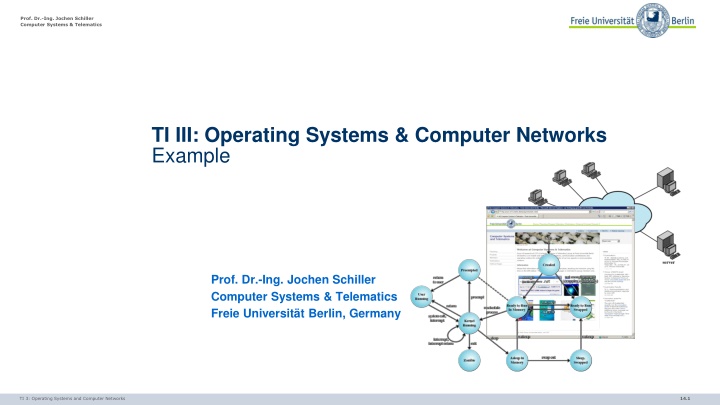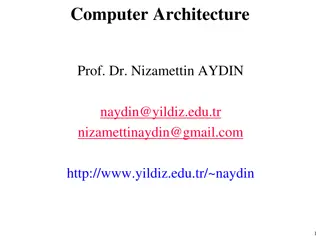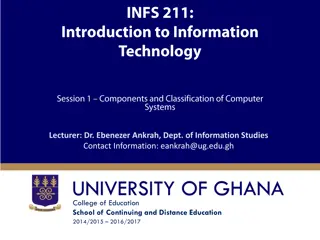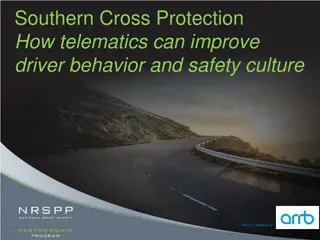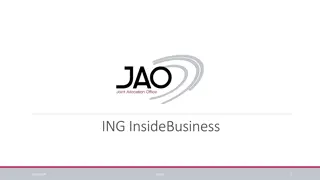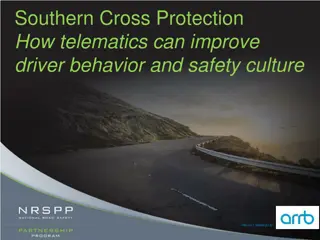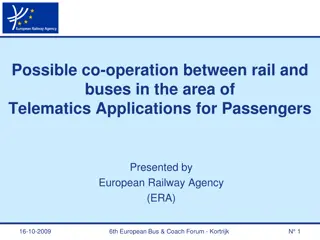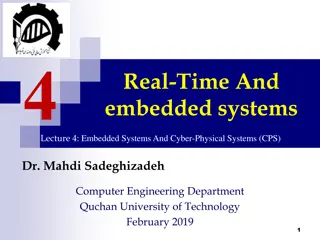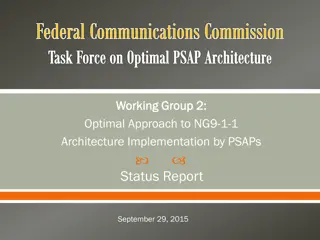Overview of Prof. Dr.-Ing. Jochen Schiller's Computer Systems & Telematics
This content discusses various aspects of computer systems and telematics as taught by Prof. Dr.-Ing. Jochen Schiller at Freie Universität Berlin, Germany. It covers topics such as operating systems, computer networks, network security, and examples illustrating key concepts. The content explains processes like keyboard interrupts, interrupt service routines, and the functioning of web browsers in detail. Additionally, it provides insights into how a computer system reacts to external events.
Download Presentation

Please find below an Image/Link to download the presentation.
The content on the website is provided AS IS for your information and personal use only. It may not be sold, licensed, or shared on other websites without obtaining consent from the author.If you encounter any issues during the download, it is possible that the publisher has removed the file from their server.
You are allowed to download the files provided on this website for personal or commercial use, subject to the condition that they are used lawfully. All files are the property of their respective owners.
The content on the website is provided AS IS for your information and personal use only. It may not be sold, licensed, or shared on other websites without obtaining consent from the author.
E N D
Presentation Transcript
Prof. Dr.-Ing. Jochen Schiller Computer Systems & Telematics TI III: Operating Systems & Computer Networks Example Prof. Dr.-Ing. Jochen Schiller Computer Systems & Telematics Freie Universit t Berlin, Germany TI 3: Operating Systems and Computer Networks 14.1
Content 8. Networked Computer & Internet 9. Host-to-Network 10. Internetworking 11. Transport Layer 12. Applications 13. Network Security 14. Example TI 3: Operating Systems and Computer Networks 14.2
A Comprehensive Example What happens if one presses a key on the computer? ? What if that key causes an web page to be displayed? ? TI 3: Operating Systems and Computer Networks 14.3
Keyboard Interrupt Keyboard controller raises interrupt flag CPU interrupts execution of current process and starts Interrupt Service Routine (ISR) - Unconditional jump TI 3: Operating Systems and Computer Networks 14.4
Keyboard Interrupt Handling ISR processes input from keyboard -Clears interrupt flag -Transfers data from device into buffer -Establishes owner of device -Triggers notification of user process TI 3: Operating Systems and Computer Networks 14.5
In the Meantime Main Memory Processor Registers i Process index PC Web browser is one of many processes running locally Other processes include -Other user processes (possibly of different users) -System processes implementing system services -Kernel processes i Process list b h Base Limit j Other registers Context Process A Data Program (code) b Context Process B Data h Program (code) TI 3: Operating Systems and Computer Networks 14.6 Figure 2.8 Typical Process Implementation
Web Browser Process in Detail Web browser processes Currently waiting for input -E.g. using select() Process state blocked TI 3: Operating Systems and Computer Networks 14.7
Reaction to External Event 1. 2. ISR changes process state to ready Scheduling algorithm eventually changes process state to running 2. 1. 2. 1. TI 3: Operating Systems and Computer Networks 14.8
Process Scheduling D (5) C (4) A (3) B (6) E (2) Scheduling is handled by variety of scheduling algorithms -Non-preemptive / preemptive -Maximize throughput, responsiveness, etc... Processes may have priorities -Priority inversion due to lock on shared resources -Priority inheritance TI 3: Operating Systems and Computer Networks 14.9
Web Browser Processes Event Assume input requires web browser to display a web page with a given URL 1. String processing (user space) 2. Connect to server and retrieve necessary data (system calls) 3. Render web page (user space) 4. Update user interface (system calls) TI 3: Operating Systems and Computer Networks 14.10
Client/Server Communication GET /inst/ag-tech/index.html HTTP/1.1 Host: www.inf.fu-berlin.de Pragma: no-cache .... TI 3: Operating Systems and Computer Networks 14.11
Layered Protocol Stack Web Browser Web Server Host corres- ponding to URL TI 3: Operating Systems and Computer Networks 14.12
Interaction Between Network Layers TCP UDP 4 Layered protocol architecture -Each layer uses only services of layer directly below -Each layer provides services to layer directly above Protocol independence Modularity ICMP ARP IP 3 Host-to-Network 2 NH DLH Data Link Header DLT Data Link Trailer Network Header AH PH SH TH Application Header Presentation Header Session Header Transport Header User data Data encapsulation -Lower layers treat upper layer packets as simple data -Headers contain control information for each layer Repeated encapsulation causes overhead sending AH data Application layer Application layer receiving Presentation layer Presentation layer PH data SH data Session layer Session layer Transport layer Transport layer TH data Network layer Network layer NH data DLH data DLT Data link layer Data link layer bits Physical layer Physical layer TI 3: Operating Systems and Computer Networks 14.13
Uniform Resource Locator (URL) http://cst.mi.fu-berlin.de/index.html http: Hypertext Transfer Protocol (HTTP) -Protocol for accessing web pages and related content -Implies communication over port 80 (unless other port given in URL) cst.mi.fu-berlin.de: Host name -Resolved to IP address via Domain Name System (DNS) - cst.mi.fu-berlin.de -> 160.45.117.167 index.html: Local resource name -Protocol specific parameter -Handled by web server TI 3: Operating Systems and Computer Networks 14.14
Security: HTTP over TLS/SSL HTTPS authenticates server and establishes secure connection: 1) 2) 3) 4) 5) Propose SSL parameters, send random number Agree to parameters, send random number Send public key certificate Conclude handshake negotiation Send random number encrypted with server s public key - Client and server derive session key from all three random numbers Activate negotiated parameters Send encrypted hash over previous messages - Server decrypts and verifies message Activate negotiated parameters Send encrypted hash over previous messages - Client decrypts and verifies message 1 2 3 6) 7) 4 5 8) 9) 6 7 8 Proceed to exchange regular HTTP data over secure channel 9 Source: Cisco Systems. Application Control Engine Module SSL Configuration Guide TI 3: Operating Systems and Computer Networks 14.15
Connection Setup / Transport Layer Client Server [SYN, seq=17] [SYN, seq=39, ACK=18] Connection setup Reliable end-to-end connection between processes Call to connect() initiates connection setup TCP 3-way handshake Connection parameters [seq=18, ACK=40] [seq=53, ACK=78, data= hi ] Data transfer [seq=78, ACK=55, data= ho ] CLOSED Active open /SYN Passive open Close Close [FIN] LISTEN [ACK] SYN/SYN + ACK Send/ SYN SYN/SYN + ACK SYN_RCVD SYN_SENT ACK SYN + ACK/ACK Connection release [FIN] Close /FIN ESTABLISHED [ACK] Time wait Close /FIN FIN/ACK FIN_WAIT_1 CLOSE_WAIT FIN/ACK ACK Close /FIN FIN_WAIT_2 CLOSING LAST_ACK Timeout after two segment lifetimes ACK ACK FIN/ACK CLOSED TIME_WAIT TI 3: Operating Systems and Computer Networks 14.16
Structure of Network Layer IP-Packet Congestion control (Explicit Congestion Notification) Don t Fragment Reserved More Fragments QoS class DiffServ Codepoint ECN 0 DF MF Bit 0 3 7 15 31 Version Hdr.Len DiffServ Total Length Identifier Flags Fragment Offset Time to Live Protocol Header Checksum IP Header Source Address Destination Address Options and Padding Data TI 3: Operating Systems and Computer Networks 14.17
Network Layer Routing (Local Scope) Globally unique per host addressing Routers maintain tables of known networks -Optional route to default gateway Subnetting implements logical structure -Subnet mask builds hierarchy using host part of IP address -Limits broadcasts -More efficient routing Network topology may be part of security concept 160.45.114 Campus - Institute 160.45.113 Router Router 160.45.115 160.45 Campus backbone 160.45.117 Router Internet TI 3: Operating Systems and Computer Networks 14.18
Network Layer Routing (Global Scope) Internet organized into autonomous systems (AS) -Commonly, one AS per major organization -Peering points to exchange data between ASs Intra-domain routing: OSPF, link state algorithm Inter-domain routing: BGPv4, distance vector protocol -May involve non-technical routing choices Inter Domain Routing Intra Domain Routing Large company Consumer ISP 1 Backbone service provider 2 Peering point Consumer ISP 2 Small company 1 Small company 2 TI 3: Operating Systems and Computer Networks 14.19
Data Link Layer Communication (Local Scope) Transparent communication between two directly connected nodes Services include: framing, error control, connection maintenance, acknowledgements, flow control Don t Fragment Congestion control (Explicit Congestion Notification) Reserved More Fragments QoS class DiffServ Codepoint ECN 0 DF MF Bit 0 3 7 15 31 Version Hdr.Len DiffServ Total Length Identifier Flags Fragment Offset Time to Live Protocol Header Checksum IP Header Source Address Destination Address Options and Padding Data TI 3: Operating Systems and Computer Networks 14.20
Error Detection: Cyclic Redundancy Check (CRC) Reception of a correct bit sequence: 11 0011 1001 1 1001 = 10 0001 (mod 2) 11 001 00 0001 1001 1 1001 0 0000 = remainder No remainder, thus the received bits should be error free Reception of a erroneous bit sequence: 11 1111 1000 1 1001 = 10 1001 (mod 2) 11 001 00 1101 1 1100 1 0001 0000 1 1001 0 1001 = remainder 0 There is a remainder unequal 0, thus there was definitely a transmission error TI 3: Operating Systems and Computer Networks 14.21
Errors During Transmission 0 1 0 1 1 0 0 1 1 0 0 1 0 1 0 Data Signal Inter- ference Signal with inter- ference Sampling Received data 0 1 0 1 1 0 1 1 1 0 0 0 0 1 0 1 0 1 1 0 0 1 1 0 0 1 0 1 Original data Error! TI 3: Operating Systems and Computer Networks 14.22
Physical Layer Wired transmission Twisted pair Wave guide Optical fibers Coaxial cable Packet / sequence of bits turned into physical signal Hz 103 105 107 109 1011 1013 1015 Micro waves Infra red Long wave Short wave Classical radio Signal propagation depends on physical medium (limited bandwidth, attenuation, dispersion) and background noise TV Visible light Wireless transmission Twisted pair Copper core Mapping between bits and (multi-valued) symbols Insulation Coaxial Baseband transmission vs. modulation (broadband transmission) Copper core InsulationShielding Insulation and mechanical protection Optical fiber LED Laser diode Glas core Protective layers TI 3: Operating Systems and Computer Networks 14.23
Client/Server Communication GET /inst/ag-tech/index.html HTTP/1.1 Host: www.inf.fu-berlin.de Pragma: no-cache .... TI 3: Operating Systems and Computer Networks 14.24
At the Server Main Memory Processor Registers i Process index Web server is one of many processes running locally PC i Process list b h Base Limit j Other registers Context Process A Data Program (code) b Context Process B Data h Program (code) Upon receiving packet, network interface controller (NIC) will raise interrupt Kernel will handle the packet and notify the web server process Figure 2.8 Typical Process Implementation TI 3: Operating Systems and Computer Networks 14.25
Processing of HTTP-GET Request Web server retrieves file inst/ag- tech/index.html from local file system System calls to access secondary storage Kernel maps file name to data layout on disk Web server sends data to client TI 3: Operating Systems and Computer Networks 14.26
Server Replies to Client HTTP/1.1 200 OK Date: Fri, 16 Feb 2007 11:40:34 GMT Server: Apache/1.3.6 (Unix) Transfer-Encoding: chunked Content-Type: text/html <HTML> Document according to HTML </HTML> TI 3: Operating Systems and Computer Networks 14.27
Client Data Processing Client host receives packet Kernel hands data to web browser process Web browser renders page May have to allocate memory in the process Finally, browser updates user interface via system call TI 3: Operating Systems and Computer Networks 14.28
A Comprehensive Example ! ! TI 3: Operating Systems and Computer Networks 14.29
Content 1. Introduction and Motivation 8. Networked Computer & Internet 2. Subsystems, Interrupts and System Calls 9. Host-to-Network 3. Processes 10. Internetworking 4. Memory 11. Transport Layer 5. Scheduling 12. Applications 6. I/O and File System 13. Network Security 7. Booting, Services, and Security 14. Example TI 3: Operating Systems and Computer Networks 14.30
Fin Fin TI 3: Operating Systems and Computer Networks 14.31
